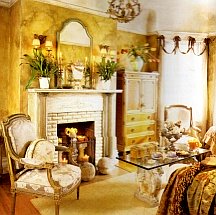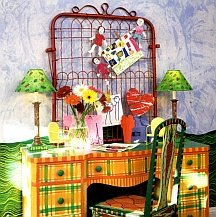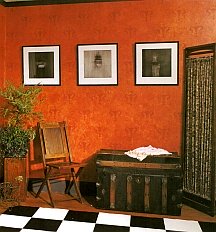Ragged Faux Paint Finishes:
Ideas, Techniques and Instructions
Ragging faux paint techniques involve dabbing or rolling a crumpled up ball of cloth on a surface, with the goal to apply or remove colored glaze and create irregular decorative patterns and imprints.
Rag painting may also go by the names "cloth distressing", "rag rolling", "cheeseclothing" or "parchment" - each is a variation on the same technique of dabbing the surface to add or subtract a glaze and leave impressions.

Ragged faux paint techniques create a smooth finish with an illusion of texture, and a surface that can resemble vellum, brushed suede, crushed velvet, soft leather, wallpaper or parchment.
As with all faux painted finishes, the final appearance depends greatly on the colors of your glaze and base coats, the glossiness and translucence of your glaze, and on the amount of the glaze applied or removed (the harder you touch the surface, the more glaze you will apply with additive techniques and remove with subtractive techniques).
Ragging Doesn't Always
Involve Rags
Also, different types of rags (cheesecloth, cotton, terry cloth, etc) all leave very different imprints on the glaze, ranging from soft and blurred, to sharp and crisp.

And while the most popular material for classic rag painting techniques is a cloth of some kind, you can successfully use even such unexpected materials as plastic bags, paper towels or bubble wrap.
Experiment with different "rags" to find the right finish/imprint for your project.
And finally, the way you bunch up the rag in your hand (loosely or in a tight wad) and the movement of your hand (straight up and down, or twisting and dragging on the surface) will determine what effect you will get - a tightly regimented and insistent pattern (as in rag rolling), or something that looks much more loose and unstructured.
You Don't Have to
Stop at Ragging
Faux paint finishes created with rags look great on their own, but most of them also make a perfect background for stenciling.

You can stencil right over the ragged wall, or paint a band as a border around the room, and decorate the border with stencil designs.
Ragging is also used in other, more complex faux painting techniques.
For example, in marbling, a rag is used to create cloudy backdrops for intricate veining.
But sometimes, depending on the colors and method, a finish produced by ragging alone can look like fantasy faux marble in its own right.
Let's Learn to Faux Paint
With Rags:
How to Faux Paint With Rags Step by Step
To rag on, you repeatedly touch the surface with a scrunched cloth (dipped in a colored glaze mix), trying to leave many impressions of the rag, without creating a recognizable pattern. The method is similar to sponging on, with the added challenge of handling a rag properly.
Negative Rag Painting: Basic and Advanced Tutorials
Ragging off is a technique where you pounce the surface covered in glaze with a cloth, to remove parts of the glaze and reveal the undercoat color. Used subtractively, the ragging effect becomes slightly softer, especially if you moisten the cloth with water first.
Tips for Faux Painting Finishes Created with a Rag
Here you will learn some tricks of the trade for ragging on, ragging off and rag rolling successfully. This is a required reading before you start your first ragging project - the advice will help you avoid many problems in the middle of the painting job.
Examples of Ragged Faux Finish Techniques
Ragged finishes come in many flavors - the possibilities for experimenting with this decorative painting technique are numerous. So for ideas and inspiration, take a look at these examples - you are sure to find at least one ragged finish that will suit your taste and your home's style.
HOUSE PAINTING TUTORIALS








